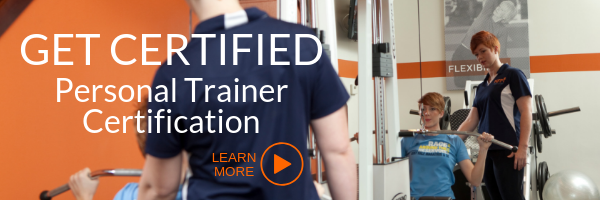A close-grip bench press is a variation of a standard bench press that creates a different challenge for our personal training clients. When conjuring up a hallmark upper body strength exercise, few things come to mind faster than a bench press. A typical “push” movement that recruits the pec complex, the deltoids, and rotator cuff stabilizers, as well as triceps and “gripping” forearm musculature, it allows max strength gains to develop while also challenging core strength and shoulder stability.
There are several variations of a basic chest press including incline, decline, standing cable, and machine presses. The close-grip press is a great option when the desire is to emphasize the triceps and anterior deltoids slightly more than a basic bench press in a similar way to a parallel bar dip: when the arms stay closer to the body, the pec major’s role is de-emphasized because of the reduced range of motion in the shoulder; concurrently, the elbow flexion is increased dramatically, involving more tricep activation.
While some folks may think, “Yeah, I get it—just bring your hands closer together and now you’ve got a close-grip bench press,” there are several considerations to bear in mind before executing this strength move.
Synergists aren’t as strong as agonists
If you are used to pushing 150 lbs on your standard bench press, know that you will have to drop the weight for a close grip variation. Not much, but probably 5 to 10% to stay in the same rep range. Depending on goals, many fitness enthusiasts who include a barbell bench press in their regular routine might do heavy lifts between 1 and 8 reps per set.
Close grip bench press endeavors less for strength and more for hypertrophy; by targeting the triceps and anterior deltoids in favor of the pec major, it may be more desirable to aim for a higher rep range 6-12.
Range of motion is more limited and should be
With a regular bench press, the recommended range is to bring the bar to tap the chest and then to push arms to full or almost full extension. With a close-grip bench press, bringing the bar all the way to the chest will place the shoulder in an excessive amount of internal rotation and risk injury.
Therefore, bring the bar to within about 3 or 4 inches of reaching the chest before returning to the start position. Also, try to keep elbows tucked close to the body; the further away the elbows are from the body the greater the glenohumeral internal rotation will be, i.e., not-great positioning.
Grip distance can vary
The closer your hands, the greater the emphasis on the triceps over the pecs, and hence the lighter the weight should be. A slighter wider grip than this (imagine the arms are perfectly parallel) will still recruit the pecs to a moderate degree and is a great option for someone recovering from a shoulder injury or for whom a standard bench press is contraindicated.
Modality can vary
This movement can be accomplished with an EZ-Curl bar, a multi-grip bar (which is the one with an oblong center and crossing lines of bars through the center), dumbbells (consider hooks for heavy weights), kettlebells, or resistance bands. The important thing is that the grip stays consistent and comfortable, and the movement can be executed without pain.
Safety First
As always, if you are a trainer introducing this movement to a client for the first time, spot him or her attentively. The closer grip makes balancing the barbell much more difficult than a standard bench press. Even with lighter weight, a strength disparity or postural inefficiency may become more apparent in this position causing the weight to dip to one side. If this happens assess (or reassess) shoulder mobility to find out where the inadequacy is before keeping the close-grip bench press in the routine.
Execution of a close-grip bench press
NFPT Publisher Michele G Rogers, MA, NFPT-CPT and EBFA Barefoot Training Specialist manages and coordinates educational blogs and social media content for NFPT, as well as NFPT exam development. She’s been a personal trainer and health coach for over 20 years fueled by a lifetime passion for all things health and fitness. Her mission is to raise kinesthetic awareness and nurture a mind-body connection, helping people achieve a higher state of health and wellness. After battling and conquering chronic back pain and becoming a parent, Michele aims her training approach to emphasize fluidity of movement, corrective exercise, and pain resolution. She holds a master’s degree in Applied Health Psychology from Northern Arizona University. Follow Michele on Instagram.


